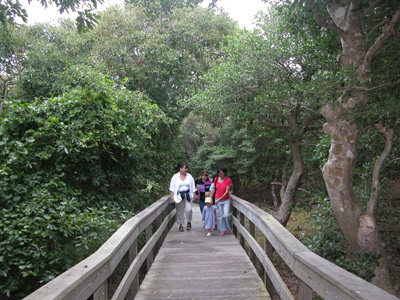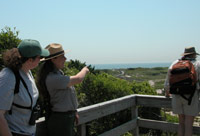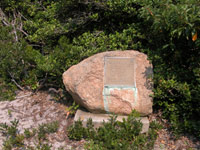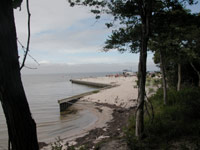 |

|
| The Sunken Forest at Fire Island is a rare Maritime Holly Forest. While not really "sunken," the forest has the appearance of being below sea level, as the trail drops down the back side of the secondary dune into a lush canopy of trees. |
|
 |
| As you "emerge" from Fire Island's Sunken Forest, you can see the ocean beyond the swale and primary dune line. Standing on top of the well-developed secondary dune, the forest has the appearance of being below the level of the sea. |
 |
Fire Island's Sunken Forest is a very rare ecological community. The Maritime Holly Forest is only found behind well-established sand dunes along the Atlantic coast from New Jersey to Massachusetts. It is one of six forest types recognized in the . According to the New York Natural Heritage Program, this state's maritime holly forest was ranked in 2001 as "globally rare" or "G1G2 S1" meaning there are few remaining occurrences of this assemblage of plants throughout the world.
Today you can easily visit this rare habitat from May to October, when ferries run from Sayville to Sailors Haven. Throughout the year you may stroll along the boardwalk, although facilities (restrooms) and other services are not available when ferry service is not operating.
|
 |
| "A Primeval Holly Forest: A sanctuary for wildlife; A field for study by scientist and lover of nature, a retreat for the refreshment of the human spirit. Enter here to enjoy but not to injure or destroy." |
 |
First protected in the 1950s as the Sunken Forest Preserve, this area is now a major component of Fire Island National Seashore.
|
|
The maritime holly forest of Fire Island is dominated by American holly (Ilex opaca), some trees estimated to be up to 300 years old. Other trees in this forest canopy include the sassafras (Sassafras albidum), shadbush or serviceberry (Amelanchier canadensis), and other hardwoods that are able to develop behind tall secondary dunes. The black oak (Quercus velutina), post oak (Quercus stellata), black cherry (Prunus serotina), and pitch pine (Pinus rigida) may be seen in the Sunken Forest, although none of these trees will grow higher than the dunes that protect them. A fully mature oak may be no more than 25 feet high when exposed to harsh maritime conditions.
In low depressions where fresh water can accumulate, bog species may grow. Red maple (Acer rubrum), blackgum (Nyssa sylvatica), blueberry (Vaccinium sp.) and other shrubs, and sphagnum moss and ferns are also found in the Sunken Forest.
Vines are particularly abundant and add to the mystique of the Sunken Forest. Wild grapes (Vitis spp.), greenbriar (Smilax rotundifolia), Virginia creeper (Parthenocissus quinquefolia), and poison ivy (Toxicodendron radicans) are common. In addition to providing cover, their fruits provide food for a variety of birds and other wildlife that may be seen in the Sunken Forest.
|
|
The shrub layer of the Sunken Forest includes saplings of species in the tree layer, usually American holly (Ilex opaca), blackgum (Nyssa sylvatica), black cherry (Prunus serotina), and serviceberry (Amelanchier canadensis). Shrubs of bayberry (Myrica pensylvanica), highbush blueberry (Vaccinium corymbosum), black huckleberry (Gaylussacia baccata) and inkberry (Ilex glabra) may be seen but are less common. The herbaceous layer is now poorly developed, and is characterized by Pennsylvania sedge (Carex pensylvanica), with starflower (Trientalis borealis) and Canada mayflower (Maianthemum canadense) as occasional associates in the spring. Historical studies of the vegetation of the Sunken Forest has revealed a substantial change in the composition of the shrub and herb layers since 1967, when huckleberry (Gaylussacia baccata) and blueberry (Vaccinium corymbosum) were regular associates of the shrub layer and wild sarsasparilla (Aralia nudicaulis), starry false solomon's seal (Smilacina stellata), brackenfern (Pteridium aquilinum), starflower (Trientalis borealis), Canada mayflower (Maianthemum canadense), herb robert (Geranium robertianum) and pink ladies slipper (Cypripedium acaule) were frequent associates of the herbaceous layer. These changes may be attributable to heavy deer browse as a result of the increase in the deer population in recent decades (Art 1987, Art 1992).
|
 |
| West side of Sailors Haven Marina, as seen from the Sunken Forest boardwalk trail. |
 |
The northern shoreline of the Sunken Forest is threatened by erosion, as the bayside lateral transport of sand is impacted by the hardened structures of the Sailors Haven Marina.
As Fire Island National Seashore continues to work on its new General Management Plan (GMP), alternatives for protecting resources and providing for public enjoyment will be considered.
|
|
Learn More
, Fire Island National Seashore, New York
Henry Warren Art, 1976
Leslie A. Sirkin, 1972
Sunken Forest Trail Guide (1977, revised 1988)
Although the trail numbers have been rearranged and some of the scientific names have changed, this out-of-print booklet includes a lot of good information for study. Visit the Sunken Forest and compare the plants and animals you can see today with those identified in this booklet, and you may be able to see how some conditions have changed over the past twenty years.
|
|
|
|

Discover the Sunken Forest
A good way to explore the maritime holly forest at Sailors Haven is to take a guided tour.
more... | | 
Sailors Haven Visitor Center
Park rangers provide information and help you learn more about the Sunken Forest and seashore life.
more... | | 
Sailors Haven Facility Hours & Rates
Check your opportunities to explore and enjoy the Sunken Forest and Sailors Haven facilities.
more... | |
|
|






